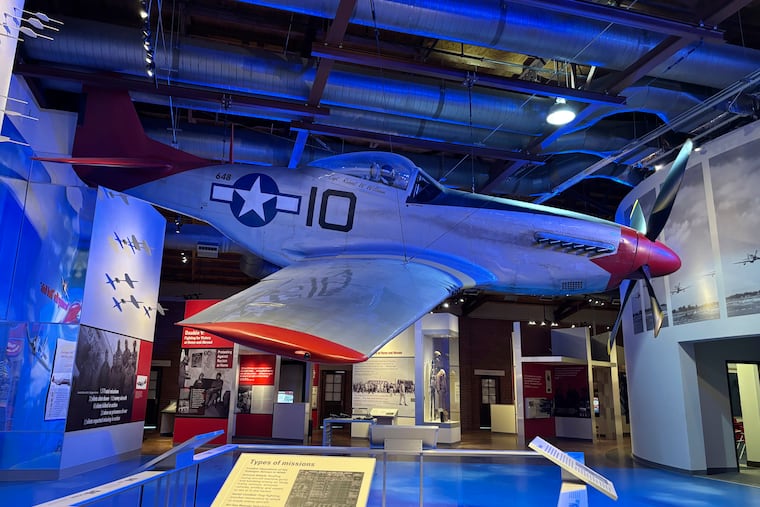80 years ago this summer, a handful of Black troops from Philly helped lead the fight to integrate the military
While African American troops were helping to end World War II overseas, their counterparts here at home were leading the fight to fully end segregated armed forces.

When we hear “Tuskegee Airmen,” we immediately think of the first African American military pilots and their exemplary record of protecting bombers from Nazi fighter planes. However, they also played a little-known role in ensuring the full integration of the armed forces and creating a template for civil disobedience campaigns that is still used by activists today. And a handful of those military pioneers were from Philadelphia.
In mid-1943, the Army formed the all-Black 477th Bombardment Group, which required training of bomber pilots as well as navigators, bombardiers, gunners, and ground personnel.
During World War II, Army officer classroom training was integrated, but lodging and sleeping quarters were segregated, except for that of Black officers — with what was then known as the Army Air Forces — whose training was completely segregated.
Army policy clearly stated that officers’ clubs were to be open to all officers. Nevertheless, various base commanders maintained segregation, rankling Black officers.
In 1944, the training of the 477th Bombardment Group began at Michigan’s Selfridge Field. After some African American officers tried to use that base’s officers club, they were stopped.
Afterward, Maj. Gen. Frank O. Hunter, part of whose duties included overseeing the training of Black officers, addressed the men who’d tried to enter the club.
Hunter violated Army policy by defiantly proclaiming “This is my base and, as long as I am in command, there will be no social mixing of the white and colored officers.”
Pentagon officials sensed trouble and quickly transferred the 477th to Kentucky’s Godman Field, a much smaller airfield. The officers of the 477th encountered no problems using Godman’s officers club as the white officers decamped and joined the nearby segregated one at Fort Knox.
However, Godman was inadequate for training the entire 477th, so it was divided into two groups.
The Army realized that training the 477th at two separate bases was delaying the unit’s combat readiness, and in March 1945, it transferred both halves to Seymour, Indiana’s Freeman Field, a much larger field, to complete their training.
Before their arrival, Col. Robert Selway Jr., the 477th’s commander, established two officers clubs without labeling them “white” or “colored.”
Instead, one was for the exclusive use of supervisors and trainers, who were white, and the other for the exclusive use of the overseas training group, who were Black.
The Black officers quickly saw through this flagrant attempt to segregate them and violate Army regulations.
Over the course of several days in early April 1945, some Black officers, including 2nd Lt. Roger “Bill” Terry attempted to enter the club for supervisors and trainers, and declared that they would not leave until they were served — a precursor to the sit-ins and lunch counter demonstrations that would come to define nonviolent resistance during the Civil Rights Movement.
The Black officers were eventually arrested in an incident that came to be known as the Freeman Field mutiny. Selway ordered over 400 Black officers to sign a form acknowledging the existence of two distinct officers clubs and that they were only entitled to use one of them.
The Black officers quickly saw through this flagrant attempt to segregate them and violate Army regulations.
Ultimately, 101 Black officers refused to sign this illegal order. On April 12, 1945, Selway ordered them arrested, placed under heavily armed guard, and flown back to Godman to await courts-martial.
At least three of the 101 were from Philadelphia: Argonne F. Harden, Frederick H. Samuels, and Eugene L. Woodson. As it so happens, Woodson was the brother of Waverly B. Woodson Jr., the Philadelphian who less than a year earlier was one of the heroes of the D-Day invasion, treating roughly 200 casualties on Omaha Beach during the deadliest stretch of fighting.
The bold defiance of Selway’s illegal order by these Tuskegee Airmen was quickly publicized by the African American press and the NAACP.
The news also reached Gen. Henry H. Arnold, head of the Army Air Forces, and Gen. George C. Marshall, Army chief of staff, who ordered the officers released but with a notice of their arrest inserted into their service records.
As a result of these 101 brave Tuskegee Airmen, who risked imprisonment, bad conduct discharges, and the potential loss of their GI Bill benefits to stand up to racism, Col. Benjamin O. Davis Jr., the extraordinary leader of the Tuskegee Airmen, was appointed as Selway’s replacement to lead the 477th. On July 1, 1945, Davis was also appointed as America’s first Black commander of a military installation.
Despite releasing the arrested officers, the Army initiated court-martial proceedings for insubordination against Terry and two other officers. On July 3, 1945, Terry was convicted of “jostling” an officer at the Officers Club. He was fined $150, reduced in rank, and dishonorably discharged.
In 1995, the Air Force agreed to remove the disciplinary letters from the files of the officers — but only for those who requested their removal — corrected Terry’s discharge to honorable, and restored his rank and fine.
The war ended 44 days after Terry’s conviction, so the 477th never deployed overseas on a combat mission, but it will always be remembered as having scored a hard-fought victory over Army racism — and perhaps also playing a crucial role in inspiring a broader movement for social change.
Paul L. Newman is an amateur historian of African American history. He has written a miniseries docudrama on the African American civil rights movement of the first half of the 20th century.
Editor’s Note: An earlier version of this essay misidentified Gen. George C. Marshall as secretary of the Army in summer 1945. The general was the Army’s chief of staff until November of that year.